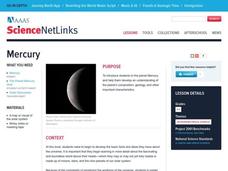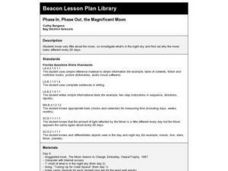American Museum of Natural History
A Closer Look at Mars
A website looks at how we know so much about Mars—telescopes, robots, and spacecraft—and the search for martian life. Following the informational text are three questions that quiz pupils about possible life on Mars.
Curated OER
Two-Point Perspective
Seventh graders will learn to create the illusion of depth on a two dimensional surface using the technique of perspective.Analyze famous works of art and photographs of local architecture and identify how each is using perspective....
Curated OER
Vocab-u-lous! Build a Fabulous Vocab: Words Beginning with SC
In this vocabulary worksheet, students select the best word choice to complete the sentence. They are challenged with words that have sc-blends.
Curated OER
How the Chipmunk Got its Stripes
In this comprehension worksheet, students complete multiple choice and short answer questions for the legend How the Chipmunk Got Its Stripes. Students complete 8 questions total.
Curated OER
Our Changing View of the Solar System
Students identify and name the eight planets and the five dwarf planets in our solar system. In this space science lesson, students view a slideshow of the planets and label them on an included Solar System chart.
Curated OER
Timekeeping by the Sun
Students measure shadows to learn about the Sun-Earth relationship. In this astronomy lesson, students create a shadow stick of a Pokemon character and record measurements of its shadow in a data chart. Follow-up discussions guide...
Curated OER
Sunny Delight
First graders explore completing experiments through the scientific method.
Curated OER
Cloudy with a Chance of Meatballs Activities
"Cloudy with a Chance of Meatballs", in its book or movie form, rains down lesson possibilities.
Curated OER
Lunar Lollipops
Students simulate the phases of the moon using a lamp and styrofoam balls. In this lunar phases lesson, students stand around a lamp and act as Earth. They hold styrofoam balls and rotate to show the phases of the moon.
Curated OER
Planetary Alignments
In this planetary alignments learning exercise, students use 2 different methods to find out when planet alignments will occur. They use a three number series and they use least common multiples to find out when Mercury and Venus will...
Curated OER
Solar System Search
Students research topics related to space and the planets using the Internet. They explore various websites, construct scale models of the solar system, and create a travel brochure using HyperStudio computer software.
Curated OER
Wacky Weather
In this weather worksheet, students read a 3 page story about a girl who notices unusual weather patterns. Included in the story is information about climate, temperature, tides and wind. Students then answer 6 essay questions.
Curated OER
What Shape is the Moon Tonight?
Young scholars understand that the moon appears differently throughout the month. In this phases of the moon lesson, students observe and record the phases of the moon.
Curated OER
The Little Fluffy White Cloud
In this reading comprehension worksheet, students read, analyze and interpret the short story "The Little Fluffy White Cloud" and then answer eighteen comprehension questions about the short story.
Curated OER
Sampling Rocks
Students investigate rocks. In this earth science instructional activity, students collect rocks from the schoolyard and describe each of the rocks. Students measure and weigh each rock and record the results. Students create a rock...
Curated OER
Country Sayings Exercise
In this idioms instructional activity, students read 12 country expressions or colloquial expressions and then match each with its correct meaning, Students then write down 3 colloquial expressions or idioms from their language and...
Curated OER
Lunar Cycle
Students recognize that the eight phases of the moon repeat. For this lunar cycle lesson, students experiment to understand the phases of the moon. Students make observations and complete a "the Moon I See" worksheet. Students...
Curated OER
Phases of the Moon
For this moon phases worksheet, students learn about the different phases that the moon goes through. They then use the information the learned to answer the 9 questions in the packet. The answers are on the last page.
Curated OER
Mercury
Students study the planet Mercury and develop an understanding of the planet's composition, geology, and other important characteristics. They explore a Web resource on the planet Mercury which is the central focus of this lesson.
Curated OER
Cosmic Wheels
Learners build a scale model of the Solar System and determine the time other planets take to travel around the Sun in comparison to the time of the Earth's revolution. The velocity of the planets are also determined in this lesson.
Curated OER
Moon
Students discover scientific facts about the Moon and how
some American Indian Tribes used the moon to measure time.
They accomplish this by listening to stories and poetry, writing
stories, communicating with an astronaut,...
Curated OER
Simple Machines: The Wede & Lever
Students describe how wedge and lever makes work easier. In this physics lesson plan, students analyze experimental data by creating a graph to see the trends. They calculate the work done and mechanical advantage of these simple machines.
Curated OER
The Participial Phrase
Need a review practice exercise for participial phrases? The assumption here is that young grammarians are already familiar with the grammar principles and terms and are ready to show their understanding of participial phrases, and for...
Curated OER
Phase In, Phase Out, the Magnificent Moon
First graders discuss why the moon appears to change shape. They use flashlights and balls to simulate the sun's light shining on the moon during its different phases. They read books, paint pictures and write sentences about the moon.

























